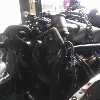2000SL2
Member
- Joined
- August 3, 2004
- Messages
- 19
- Reaction score
- 0
- City, State
- Muse, PA
- Year, Model & Trim Level
- 1993 XLT 4X4
OK, I had to remove the drivers side head on the wife's '93 XLT. When I put it all back together the #4 cylinder filled with coolant and the coolant system got pressurized. I thought the problem was with the papery Felpro lower intake manifold gasket that was a PITA to install. I took everything apart again and put it all back together again using Ford OEM gaskets including the newer metal intake manifold gasket. well, this time it wasn't so bad. But, it had a lot of white smoke coming out of the tail pipe and the coolant system got pressurized again. It wasn't as bad this time. The first time coolant shot out of the radiator cap when removed. This time just a little bubbling could be heard. I have been stuck on the intake manifold gasket, but, I've been thinking that the pressurization of the coolant system could only be the head gasket. I used new head bolts and followed the torque procedures as specified in the Haynes manual. Perhaps I should just try tightening the head bolts a little more? Also, could the coolant system become pressurized if the lower intake manifold didn't seal? I'm thinking not. Thanks!!!
Brian
Brian










